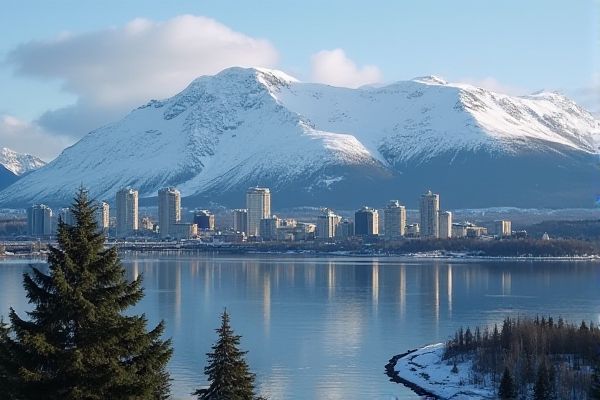
Dining and food culture in Alaska: Seafood prominence: Salmon, halibut, and crab. Native Alaskan cuisine influences. Farm-to-table trend growing. Unique game meats: moose, caribou, reindeer. Seasonal availability affects options. Importance of sustainable harvesting practices. Diverse culinary festivals year-round. Traditional foods: agutuk, akutaq ("Eskimo ice cream"). Cultural importance of salmon fishing. Remote areas may have limited dining options.
Seafood prominence: Salmon, halibut, and crab.
Alaska is renowned for its abundant and sustainable seafood, with salmon, halibut, and crab being among the most popular and iconic dishes. These seafood options are often prepared in classic Alaskan styles, such as grilled salmon on a cedar plank, pan-seared halibut, and king crab legs slathered in butter, highlighting the state's rich culinary heritage. For more insights into why Alaska remains a paradise for seafood lovers, visit this Last Culinary Frontier article and explore the depth of Alaskan flavors and traditions.
Native Alaskan cuisine influences.
Native Alaskan cuisine is deeply rooted in traditional subsistence foods, including wild berries, cold water seafood, and wild game. Dishes like akutaq (Eskimo ice cream) and muktuk sushi rolls reflect a rich cultural heritage and adaptation to modern culinary practices while maintaining strong connections to the land and community traditions. These culinary practices are elaborated on Traditional Alaskan Foods, emphasizing how food not only nourishes the body but also warms the spirit, fortifying bonds across communities. The inclusion of such foods in daily life showcases the resilience and adaptability of Native Alaskan culture.
Farm-to-table trend growing.
The Farm-to-Table trend in Alaska is gaining momentum, with restaurants and consumers increasingly supporting local farmers despite the logistical challenges of consolidating and delivering products across the state. This movement is driven by a growing demand for fresh, locally produced food, highlighting the importance of initiatives like the Dining on Alaska Grown Products. Such efforts not only benefit the local economy but also provide healthier eating options for Alaskan residents.
Unique game meats: moose, caribou, reindeer.
In Alaska, unique game meats such as moose, caribou, and reindeer are integral to the local food culture. Caribou, for example, is a staple food source, often prepared through traditional methods like fermenting in the animal's stomach or burying in snow to tenderize the meat. Meanwhile, moose and reindeer are valued for their nutritional benefits and unique flavors, with reindeer sausage being a popular street food. For more detailed insights into the traditional culinary practices of Alaska, you can visit the Alaska Department of Fish and Game website, which provides an extensive look into the region's wildlife and gastronomy.
Seasonal availability affects options.
In Alaska, the short and intense growing season significantly influences the availability of local fruits and vegetables, with peak production occurring from June to September and relying on cold storage and preservation techniques to extend the availability of produce into the winter months. This seasonal variability shapes the local food culture, emphasizing fresh produce in summer, stored and preserved foods in winter, and innovative methods like greenhouse farming to maintain access to fresh ingredients year-round. Discover more about the unique rhythm of Alaskan agriculture by visiting The Spruce Eats.
Importance of sustainable harvesting practices.
In Alaska, sustainable harvesting practices are crucial, with a science-based approach to fisheries management ensuring the long-term health of fish stocks, communities, and ecosystems. This approach incorporates principles such as full resource utilization and strong governance to maintain the state's renowned seafood sustainability.
Diverse culinary festivals year-round.
Alaska hosts a diverse array of culinary festivals year-round, including the Alaska State Fair with its giant vegetable contests and varied local dishes, the Kodiak Crab Festival celebrating seafood, the Valdez Pink Salmon Festival highlighting sustainable seafood, and the Salmonfest in Ninilchik, which combines fish, music, and local beers. These festivals showcase Alaska's unique cuisine, from traditional ingredients like berries and salmon to game meats and craft beers, offering a rich culinary experience throughout the year.
Traditional foods: agutuk, akutaq (“Eskimo ice cream”).
Akutaq, often referred to as "Eskimo ice cream," is a traditional Alaskan dish crafted by indigenous communities. It comprises a blend of animal fats such as reindeer or seal, fish, oil, berries, and ice, all whipped into a rich concoction. This sustenance-packed food is ideal for enduring harsh climates and is also part of special celebrations. The recipe varies based on region and season, frequently incorporating ingredients like polar bear, seal, or caribou. Traditionally, Akutaq is prepared by women following significant hunts or during community events, highlighting its cultural significance in Alaskan life.
Cultural importance of salmon fishing.
Salmon holds profound cultural significance in Alaska, symbolizing abundance, renewal, fertility, and dependability. It is integral to the spiritual, social, and economic lives of Native American communities, who have relied on it for thousands of years and continue to honor it through ceremonies and sustainable fishing practices. To learn more about this fascinating aspect of culture, visit the article on Alaskan Salmon Culture, which explores the deep connection between these communities and the remaining bounties of nature
Remote areas may have limited dining options.
In remote areas of Alaska, dining options are severely limited due to long and often interrupted supply chains, leading to high food insecurity rates. This situation is particularly prevalent in rural and Alaska Native communities where imported food is the primary source of nutrition. For more detailed insights, please visit the Food Security and Climate Change Alaska section of the Climate Hubs USDA website.
